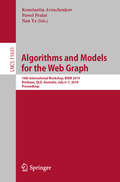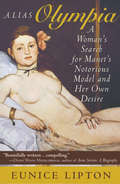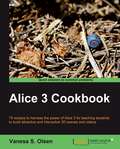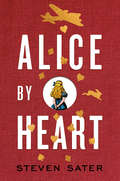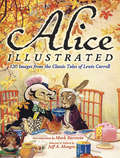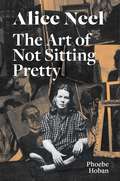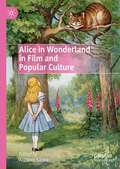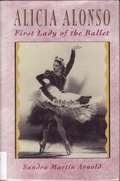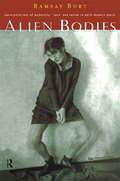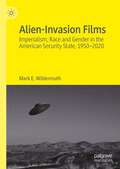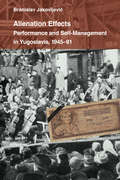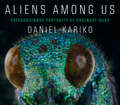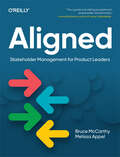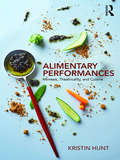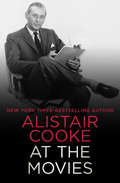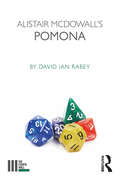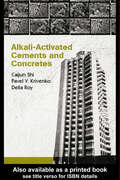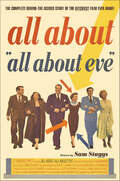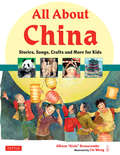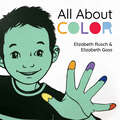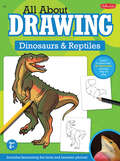- Table View
- List View
Algorithms and Models for the Web Graph: 16th International Workshop, WAW 2019, Brisbane, QLD, Australia, July 6–7, 2019, Proceedings (Lecture Notes in Computer Science #11631)
by Paweł Prałat Konstantin Avrachenkov Nan YeThis book constitutes the proceedings of the 16th International Workshop on Algorithms and Models for the Web Graph, WAW 2019, held in Brisbane, QLD, Australia, in July 2019. The 9 full papers presented in this volume were carefully reviewed and selected from 13 submissions. The papers cover topics of all aspects of algorithmic and mathematical research in the areas pertaining to the World Wide Web, espousing the view of complex data as networks.
Algorithms in Machine Learning Paradigms (Studies in Computational Intelligence #870)
by Paramartha Dutta Jyotsna Kumar Mandal Somnath Mukhopadhyay Kousik DasguptaThis book presents studies involving algorithms in the machine learning paradigms. It discusses a variety of learning problems with diverse applications, including prediction, concept learning, explanation-based learning, case-based (exemplar-based) learning, statistical rule-based learning, feature extraction-based learning, optimization-based learning, quantum-inspired learning, multi-criteria-based learning and hybrid intelligence-based learning.
Alias Olympia
by Eunice LiptonEunice Lipton was a fledging art historian when she first became intrigued by Victorine Meurent, the nineteenth-century model who appeared in Edouard Manet's most famous paintings, only to vanish from history in a haze of degrading hearsay. But had this bold and spirited beauty really descended into prostitution, drunkenness, and early death -- or did her life, hidden from history, take a different course altogether? Eunice Lipton's search for the answer combines the suspense of a detective story with the revelatory power of art, peeling off ayers of lies to reveal startling truths about Victorine Meurent -- and about Lipton herself.
Alice 3 Cookbook
by Vanesa S. OlsenPart of Packt's cookbook series, each chapter focuses on a different aspect of working with Alice. Each recipe has practical, step-by-step instructions with lots of screenshots. This book is designed primarily for teachers developing education plans and willing to exploit 3D environments using Alice 3. Alice users who want to improve their Alice programming skills will also find this book useful as it offers innovative 3D models in action. Some basic knowledge of Alice and how it works is necessary, although you are not expected to have worked with version 3 before.
Alice By Heart: Victim Sidekick Boyfriend Me; Journey To X; Little Foot; Prince Of Denmark; Socialism Is Great; The Grandfathers; Alice By Heart; Generation Next; So You Think Youre A Superhero?; The Ritual (Play Anthologies Ser.)
by Steven SaterA young girl takes refuge in a London Tube station during WWII and confronts grief, loss, and first love with the help of her favorite book, Alice in Wonderland, in the debut novel from Tony Award-winning playwright Steven Sater.London, 1940. Amidst the rubble of the Blitz of World War II, fifteen-year-old Alice Spencer and her best friend, Alfred, are forced to take shelter in an underground tube station. Sick with tuberculosis, Alfred is quarantined, with doctors saying he won't make it through the night. In her desperation to keep him holding on, Alice turns to their favorite pastime: recalling the book that bonded them, and telling the story that she knows by heart--the story of Alice in Wonderland. What follows is a stunning, fantastical journey that blends Alice's two worlds: her war-ravaged homeland being held together by nurses and soldiers and Winston Churchill, and her beloved Wonderland, a welcome distraction from the bombs and the death, but a place where one rule always applies: the pages must keep turning. But then the lines between these two worlds begin to blur. Is that a militant Red Cross Nurse demanding that Alice get BACK. TO. HER. BED!, or is it the infamous Queen of Hearts saying...something about her head? Soon, Alice must decide whether to stay in Wonderland forever, or embrace the pain of reality if that's what it means to grow up. In this gorgeous YA adaption of his off-Broadway musical, the Tony Award-winning co-creator of Spring Awakening encourages us all to celebrate the transformational power of the imagination, even in the harshest of times.
Alice Illustrated: 120 Images from the Classic Tales of Lewis Carroll
by Barry Moser Jeff A. Menges Mark BursteinFew books of the past 200 years have captured the imagination of illustrators like Carroll's tale of Wonderland. This original compilation features the interpretations of dozens of artists, including Arthur Rackham, Charles Robinson, and original illustrator John Tenniel. Editor Jeff Menges discusses the artists and their work, and noted collector Mark Burstein shares a bibliophile's perspective.
Alice Munro
by Brenda PfausAlice Munro, recipient of the 2013 Nobel Prize in Literature, is undoubtedly among Canada’s greatest living writers. In this unique, intriguing collection, Brenda Pfaus gives fresh insights into some of Munro’s most enduring works: Lives of Girls and Women (1971), Who Do You Think You Are? (1978), Dance of the Happy Shades (1968), Something I’ve Been Meaning to Tell You (1974), and The Moons of Jupiter (1982). This collection of essays reaches from the early years of Munro’s career through her prime as a writer, when she penned her most influential works.
Alice Neel: The Art of Not Sitting Pretty
by Phoebe Hoban Alice Neel&“Neel emerges as a resolute survivor who lived by her convictions, both aesthetically and politically.&” —Publisher&’s Weekly Phoebe Hoban&’s definitive biography of the renowned American painter Alice Neel tells the unforgettable story of an artist whose life spanned the twentieth century, from women&’s suffrage through the Depression, McCarthyism, the civil rights movement, the sexual revolution, and second-wave feminism. Throughout her life and work, Neel constantly challenged convention, ultimately gaining an enduring place in the canon.Alice Neel&’s stated goal was to &“capture the zeitgeist.&” Born into a proper Victorian family at the turn of the twentieth century, Neel reached voting age during suffrage. A quintessential bohemian, she was one of the first artists participating in the Easel Project of the Works Progress Administration, documenting the challenges of life during the Depression. An avowed humanist, Neel chose to paint the world around her, sticking to figurative work even during the peak of abstract expressionism. Neel never ceased pushing the envelope, creating a unique chronicle of her time. Neel was fiercely democratic in selecting her subjects, who represent an extraordinarily diverse population—from such legendary figures as Joe Gould to her Spanish Harlem neighbors in the 1940s, the art critic Meyer Schapiro, Nobel Laureate Linus Pauling, Andy Warhol, and major figures of the labor, civil rights, and feminist movements—producing an indelible portrait of twentieth-century America. By dictating her own terms, Neel was able to transcend such personal tragedy as the death of her infant daughter, Santillana, a nervous breakdown and suicide attempts, and the separation from her second child, Isabetta. After spending much of her career in relative obscurity, Neel finally received a major museum retrospective in 1974, at the Whitney Museum of American Art, in New York. In this first paperback edition of the authoritative biography of Neel, which serves also as a cultural history of twentieth-century New York, Hoban documents the tumultuous life of the artist in vivid detail, creating a portrait as incisive as Neel&’s relentlessly honest paintings. With a new introduction by Hoban that explores Neel&’s enduring relevance, this biography is essential to understanding and appreciating the life and work of one of America&’s foremost artists.
Alice in Wonderland in Film and Popular Culture
by Antonio SannaThis book examines the many reincarnations of Carroll’s texts, illuminating how the meaning of the original books has been re-negotiated through adaptations, appropriations, and transmediality. The volume is an edited collection of eighteen essays and is divided into three sections that examine the re-interpretations of Alice in Wonderland and Through the Looking-Glass in literature, film, and other media (including the branches of commerce, music videos, videogames, and madness studies). This collection is an addition to the existing work on Alice in Wonderland and its sequels, adaptations, and appropriations, and helps readers to have a more comprehensive view of the extent to which the Alice story world is vast and always growing.
Alicia Alonso: First Lady of the Ballet
by Sandra Martin ArnoldA biography of the Cuban ballerina who founded her own ballet school and company, performed with the Ballet Russe, and continued to dance even after she lost her sight.
Alien Bodies: Representations of Modernity, 'Race' and Nation in Early Modern Dance
by Ramsay BurtAlien Bodies is a fascinating examination of dance in Germany, France, and the United States during the 1920s and 1930s. Ranging across ballet and modern dance, dance in the cinema and Revue, Ramsay Burt looks at the work of European, African American, and white American artists. Among the artists who feature are: * Josephine Baker * Jean Borlin * George Balanchine * Jean Cocteau * Valeska Gert * Katherine Dunham * Fernand Leger * Kurt Jooss * Doris Humphrey Concerned with how artists responded to the alienating experiences of modern life, Alien Bodies focuses on issues of: * national and 'racial' identity * the new spaces of modernity * fascists uses of mass spectacles * ritual and primitivism in modern dance * the 'New Woman' and the slender modern body
Alien-Invasion Films: Imperialism, Race and Gender in the American Security State, 1950-2020
by Mark E. WildermuthThis book studies American science fiction films depicting invasions of the USA and Earth by extra- terrestrials within the context of imperialism from 1950–2020. It shows how such films imagine America and its allies as objects of colonial control. This trope enables filmmakers to explore the ethics of American interventionism abroad either by defending the status quo or by questioning interventionism. The study shows how these films comment on American domestic hegemonic practices regarding racial or gender hierarchies, as well as hegemonic practices abroad. Beginning with the Cold War consensus in the 1950s, the study shows how hegemony at home and abroad promotes division in the culture.
Alienation Effects: Performance and Self-Management in Yugoslavia, 1945-91
by Branislav JakovljevicIn the 1970s, Yugoslavia emerged as a dynamic environment for conceptual and performance art. At the same time, it pursued its own form of political economy of socialist self-management. Alienation Effects argues that a deep relationship existed between the democratization of the arts and industrial democracy, resulting in a culture difficult to classify. The book challenges the assumption that the art emerging in Eastern Europe before 1989 was either "official" or "dissident" art; and shows thatthe break up of Yugoslavia was not a result of "ancient hatreds" among its peoples but instead came from the distortion and defeat of the idea of self-management. The case studies include mass performances organized during state holidays; proto-performance art, such as the 1954 production of Waiting for Godot in a former concentration camp in Belgrade; student demonstrations in 1968; and body art pieces by Gina Pane, Joseph Beuys, Marina Abramovic, and others. Alienation Effects sheds new light on the work of well-known artists and scholars, including early experimental poetry by Slavoj Ž iž ek, as well as performance and conceptual artists that deserve wider, international attention.
Aliens Among Us: Extraordinary Portraits Of Ordinary Bugs
by Daniel KarikoWith more than sixty stunning photographs of pillbugs, silverfish, moths, and other household insects, Aliens Among Us depicts a hidden world flourishing in our homes. Over the course of his photography career, Daniel Kariko came to realize that many of his most stunning subjects could be found in his own subdivision in Greenville, North Carolina. Determined to show the rest of us that his experience is hardly unusual, Kariko utilizes a combination of a Scanning Electron Microscope and optical Stereo Microscope to achieve a portrait-like effect for insects and arthropods. Vibrant in color and surprising in personality, these images reveal such details as the glittering eyes of a horsefly, the strong legs of a centipede, and the fetching smile of a honeybee. Each photograph comes equipped with a full-body illustration from artist Isaac Talley, and fascinating character descriptions from entomologist Tim Christensen. Deftly blurring the lines of art and science, Aliens Among Us is the perfect guidebook for anyone interested in putting a face to the creepers under the couch.
Aliens Are Coming!
by Meghan MccarthyIt was an ordinary night in October of 1938 until a news bulletin interrupted the dance music on CBS radio–aliens were invading the United States! Meghan McCarthy’s hilarious Aliens Are Coming!tells the true story of the Halloween radio prank that duped much of the country into believing that Martians had invaded. The book uses excerpts from the actual War of the Worlds radio broadcast and includes information about the importance of radios in the 1930s (before the time of televisions and computers) as well as facts about Orson Welles and H. G. Wells, author of the novel on which the broadcast was based.
Aligned: Stakeholder Management for Product Leaders
by Bruce McCarthy Melissa AppelProduct management naturally incorporates empathy, psychology, and thinking outside the box in pursuit of the best design for products. But how often do you apply those same skills to your relationships with people in your company?By breaking the art of stakeholder management into simple lessons and frameworks, this practical book shows product managers how to manage the crucial relationships that will help you make an impact and advance your career. You'll learn how to build trusting relationships with stakeholders, optimize your communication for different audiences, get buy-in for your ideas and roadmaps, and have stakeholders appreciate it when you say no.You'll learn how to:Build and maintain trust with your stakeholdersMap your organization and identify the real power playersEstablish roles and build an extended team that works well togetherCommunicate in a way that speaks to the needs and goals of different stakeholdersGet buy-in on your ideas and roadmapMake stakeholders appreciate and support you when you say "no"Sustain buy-in over timeManage difficult stakeholders and personalities
Alimentary Performances: Mimesis, Theatricality, and Cuisine
by Kristin HuntA pea soda. An apple balloon. A cotton candy picnic. A magical mole. These are just a handful of examples of mimetic cuisine, a diverse set of culinary practices in which chefs and artists treat food as a means of representation. As theatricalised fine dining and the use of food in theatrical situations both grow in popularity, Alimentary Performances traces the origins and implications of food as a mimetic medium, used to imitate, represent, and assume a role in both theatrical and broader performance situations. Kristin Hunt's rich and wide-ranging account of food's growing representational stakes asks: What culinary approaches to mimesis can tell us about enduring philosophical debates around knowledge and authenticity How the dramaturgy of food within theatres connects with the developing role of theatrical cuisine in restaurant settings Ways in which these turns toward culinary mimeticism engender new histories, advance new epistemologies, and enable new modes of multisensory spectatorship and participation. This is an essential study for anyone interested in the intersections between food, theatre, and performance, from fine dining to fan culture and celebrity chefs to the drama of the cookbook.
Alison Bechdel: Conversations (Conversations with Comic Artists Series)
by Rachel R. MartinDue to the huge success of her graphic memoir Fun Home: A Family Tragicomic in 2006 and its subsequent Tony Award–winning musical adaptation in 2009, Alison Bechdel (b. 1960) has recently become a household name. However, Bechdel, who has won numerous awards including a MacArthur Fellowship, has been writing and drawing comics since the early 1980s. Her comic strip Dykes to Watch Out For (DTWOF) stood out as one of the first to depict lesbians in popular culture and is widely hailed as an essential LGBTQ resource. It is also from this comic strip that the wildly popular Bechdel Test—a test to gauge positive female representation in film—obtained its name. While DTWOF secured Bechdel’s role in the comics world and queer community long before her mainstream success, Bechdel now experiences notoriety that few comics artists ever achieve and that women cartoonists have never attained.Spanning from 1990 to 2017, Alison Bechdel: Conversations collects twelve interviews that illustrate how Bechdel uses her own life, relationships, and contemporary events to expose the world to what she has referred to as the “fringes of acceptability”—the comics genre as well as queer culture and identity. These interviews reveal her intentionality in the use of characters, plots, structure, and cartooning to draw her readers toward disrupting the status quo.Starting with her earliest interviews on public access television and in little-known comics and queer presses, Rachel R. Martin traces Bechdel’s career from her days with DTWOF to her popularity with Fun Home and Are You My Mother? This volume includes her “one-off” DTWOF strips from November 2016 and March 2017 (not anthologized anywhere else) and in-depth discussions of her laborious creative process as well as upcoming projects.
Alistair Cooke at the Movies
by Alistair CookeA wonderful entertainment that reflects Alistair Cooke&’s love affair with cinema, from his early days as a film critic to his iconic role as the host of Masterpiece Theatre Humphrey Bogart, Fred Astaire, Lauren Bacall, Marlene Dietrich, and Marilyn Monroe are just a few of the stars profiled, along with many directors, in this sparkling and comprehensive collection of reviews, interviews, and essays. Alistair Cooke&’s first radio talk at the BBC was in October 1934, and the subject was cinema. He had begun reviewing films in the 1920s as a Cambridge undergraduate. This anthology of his best film criticism and essays includes his many favorite subjects. In &“The Symbol Called Garbo,&” Cooke reveals the woman behind the enigmatic screen goddess. James Cagney is identified as &“one of the few technically perfect actors,&” while Charlie Chaplin was &“the funniest clown alive.&” Shirley Temple&’s multi-million-dollar appeal is explained, as is the subtlety underpinning the slapstick humor of the Marx Brothers. Directors such as Frank Capra, Fritz Lang, and Cecil B. DeMille meet with Cooke&’s high praise, while Alfred Hitchcock evokes a more complicated reaction. Full of glamorous stars, provocative opinions, and fond memories, Alistair Cooke at the Movies is a very personal and captivating guide to the golden age of Hollywood and beyond.
Alistair McDowall's Pomona (The Fourth Wall)
by David Ian Rabey‘It’s all real. All of it. Everything bad is real’ - Moe Alistair McDowall’s Pomona was first staged in 2014 and won properly startling, and startled, acclaim. Its edgeland setting permits a surrealistic disengagement of linear forms of time, which is both dreamlike and wildly funny; nightmarish and ominously enveloping. The play has as its imaginative springboard a landscape which is both real and surreal. It offers an unforgettable journey into radical uncertainty, alongside unpredictable action that presents and questions the forms by which all too much of British life is lived. Rabey offers us a wild plunge into this modern English urban rabbit hole, a haunting and bewildering high-stakes hunt for meaning and value, set in a gothic noir Manchester, possibly dystopian (or possibly not).
Alkali-Activated Cements and Concretes
by Caijun Shi Della Roy Pavel KrivenkoThis is the first English-language book to review and summarize research in alkali-activated cements and concrete. It includes coverage of new types of binder, hydration and microstructure development of alkali-activated slag cements, mechanical properties and durability of alkali-activated slag cement and concrete.
All About "All About Eve": The Complete Behind-the-Scenes Story of the Bitchiest Film Ever Made!
by Sam StaggsTo millions of fans, All About Eve represents all that's witty and wonderful in classic Hollywood movies. Its old-fashioned, larger-than-life stars--including Bette Davis, Marilyn Monroe, Anne Baxter, George Sanders, and Celeste Holm--found their best roles in Eve and its sophisticated dialogue has entered the lexicon.But there's much more to know about All About Eve. Sam Staggs has written the definitive account of the making of this fascinating movie and its enormous influence on both film and popular culture. Staggs reveals everything about the movie--from who the famous European actress Margo Channing was based on to the hot-blooded romance on-set between Bette Davis and costar Gary Merrill, from the jump-start the movie gave Marilyn Monroe's career and the capstone it put on director Joseph L. Mankeiwicz's.All About "All About Eve" is not only full of rich detail about the movie, the director, and the stars, but also about the audience who loved it when it came out and adore it to this day.
All About China
by Allison BranscombeTake the whole family on a whirlwind tour of Chinese history and culture with this delightfully illustrated book that is packed with stories, activities and games. Travel from the stone age through the dynasties to the present day with songs and crafts for kids that will teach them about Chinese language and the Chinese way of life. All About China is the next best thing to being there! China is the world's largest and most populated country boasting thousands of years of history, tradition and culture. In All About China, you'll: Discover the fantastic Chinese tales about the creation of the earth and the origin of the Moon Goddess Delve into China's multifaceted cultural heritage, visit breathtaking places and learn Chinese folk songs Take a crack at solving a tangram shape puzzle Learn about the twelve Chinese zodiac animals Try your hand at making a traditional brush painting of a panda, bamboo and other subjects All About China is an exciting and captivating introduction to the country, featuring page after page of colorful illustrations, interesting stories, amazing facts, cultural insights, engaging activities and much more. Young readers will embark on a fascinating journey through the many faces of this country, meeting its people and examining its landscape, culture and historical tapestry.
All About Color
by Elizabeth RuschA fresh picture book of simple but surprising exploration of the art, science, and emotion of color. This mindful meditation encourages children to see the world differently.Colors don&’t exist. The sky is not blue. The grass is not green. A violet is not even violet. But color still plays an important role in our lives. Color can be a signal, as in a traffic light. It can be a call for help, like a life jacket. It can help us stand out or blend in, or feel like part of a team. Colors even affect our mood: red can make us angry, blue can make us sad, and yellow can brighten our day. Young readers will never look at color the same way again.
All About Drawing: Dinosaurs & Reptiles (All About Drawing)
by Quarto Publishing GroupDiscover how to draw your favorite scaled and prehistoric creaturesPerfect for children who love to doodle, this introductory drawing book makes the art of drawing easy. Clear, easy-to-follow examples use basic shapes and colors to teach children how to draw step by step. Inside, young readers can learn simple ways to draw and color a collection of reptiles and dinosaurs. Each lesson features fun, fascinating facts about favorite species, as well as simple drawing tips to guide kids along. With All About Drawing: Reptiles and Dinosaurs, aspiring artists will be drawing their own masterpieces in no time!
